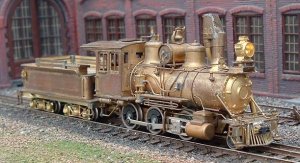If i were ever to do anything in narrow gauge( and its awfully tempting with some of the new n scale offerings) It would be based on this particular scenario in northern Mn
Alger Smith took over the Tower Lumber Company, in 1908, and two years later sold it to Wirth Cook and William O'Brien in a sale that included the Gilbert tract of timber on Trout Lake. Cook and O'Brien incorporated as the Trout Lake Lumber company. The Trout Lake Lumber Company portaged their steam boat, Ojeda, into Trout Lake over a narrow gauge railway.
Cook, who was apparently an ambitious lumberman, got into a dispute over ownership of timber lands near Tower with another lumberman. In 1916, the dispute boiled over, and an angry lynch mob chased Cook to the rail yard where he dove into the baggage car of morning train to Virginia, just as it was leaving the station. Cook settled in Virginia, and formed the Virginia and Rainy Lake Company, which became the largest white pine sawmill in the world.
The Trout Lake Lumber Company had wide-spread operations. In 1917, the company constructed a portage railroad from the north shore of Lake Vermilion to Elbow Lake. The railroad was build in May and was taken up in October of that same year. That year a 37-ton locomotive was loaded onto a barge near the mill at Tower, and floated to the Elbow Lake portage. It immediately became apparent that the locomotive was too heavy for the ground that the skeleton track railroad was laid on. The tracks sank into the swampy ground when the locomotive was run across them. A smaller 25-ton locomotive was brought in as a replacement.
In 1918, the Trout Lake Lumber Company ran out of timber and the mill was dismantled. The mill site was later used by the Minnesota Box Manufacturing Company. Large scale logging operations ended in the Tower area in the 1920s. None of the large logging companies up to that time reported losing a locomotive in the Trout Lake area. How and when the wide-spread rumor about the engine in the lake started is a mystery. But whether or not a locomotive is rusting away beneath the waves of Trout Lake, the history of logging in the Tower area showed a remarkable expenditure of ingenuity and equipment. Fortunes were made, but horses, boats and sadly men's lives were lost, and maybe somewhere between the Trout Rock and the Five Sisters Islands, in the deep water of Trout Lake, there really is a lost locomotive.
Can you imagine having a short portage Railroad to haul a boatload of Logs overland 1/2 mile or so.this could be modeled in its entirety with a portage camp,turntable etc etc



